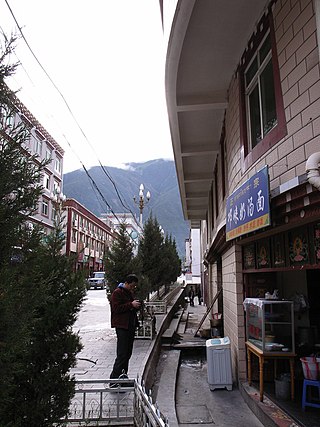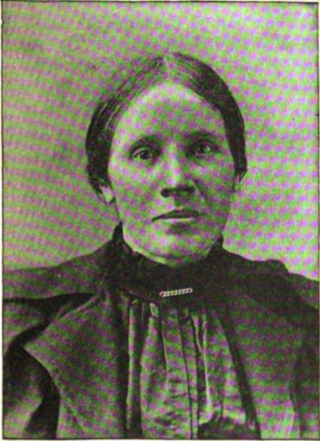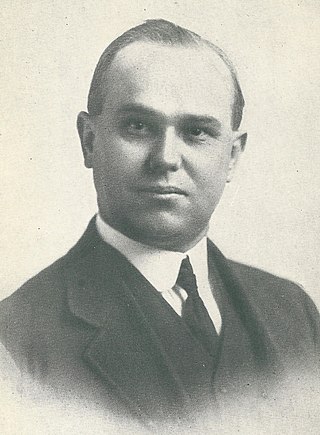Related Research Articles

Shangri-La is a fictional place in Tibet's Kunlun Mountains, described in the 1933 novel Lost Horizon by English author James Hilton. Hilton portrays Shangri-La as a mystical, harmonious valley, gently guided from a lamasery, enclosed in the western end of the Kunlun Mountains. Shangri-La has become synonymous with any earthly paradise, particularly a mythical Himalayan utopia – an enduringly happy land, isolated from the world. In the novel, the people who live in Shangri-La are almost immortal, living hundreds of years beyond the normal lifespan and only very slowly aging in appearance.

The University of Wisconsin–Milwaukee is a public urban research university in Milwaukee, Wisconsin. It is the largest university in the Milwaukee metropolitan area and a member of the University of Wisconsin System. It is also one of the two doctoral degree-granting research universities and the second largest university in Wisconsin.

Ngawang Lobsang Thupten Gyatso Jigdral Chokley Namgyal, abbreviated to Thubten Gyatso was the 13th Dalai Lama of Tibet, enthroned during a turbulent era and the collapse of the Qing Dynasty. Referred to as "the Great Thirteenth", he is also known for redeclaring Tibet's national independence, and for his reform and modernization initiatives.

The British expedition to Tibet, also known as the Younghusband expedition, began in December 1903 and lasted until September 1904. The expedition was effectively a temporary invasion by British Indian Armed Forces under the auspices of the Tibet Frontier Commission, whose purported mission was to establish diplomatic relations and resolve the dispute over the border between Tibet and Sikkim. In the nineteenth century, the British had conquered Burma and Sikkim, with the whole southern flank of Tibet coming under the control of the British Indian Empire. Tibet ruled by the Dalai Lama under the Ganden Phodrang government was a Himalayan state under the protectorate of the Chinese Qing dynasty until the 1911 Revolution, after which a period of de facto Tibetan independence (1912–1951) followed.
Stuart Carlson was an American editorial cartoonist who worked for the Milwaukee Journal Sentinel. His cartoons usually followed the moderate editorial stance of that paper.
Johannes Martin "Joe" Klotsche, was an American professor of history and the first chancellor of the University of Wisconsin–Milwaukee, serving as the chief executive of the school and its predecessors from 1946 to 1973.

The University of Wisconsin–Milwaukee at Waukesha is a two-year college located in Waukesha, in the U.S. state of Wisconsin. A branch campus of the University of Wisconsin-Milwaukee, it is part of the University of Wisconsin System. Like the other 2-year UW campuses, UWM at Waukesha's land and buildings belong to a local government unit, in this case Waukesha County. As part of the local-state partnership, the University of Wisconsin provides faculty, staff, educational programs, technology, furnishings, libraries, and supplies. In 2018, the college became a regional campus of the University of Wisconsin-Milwaukee, after previously being a part of the University of Wisconsin Colleges. The campus will close at the end of the spring 2025 semester.

Batang Town, officially Xiaqiong Town, is a town in Batang County, Garzê Tibetan Autonomous Prefecture, Sichuan Province, in the China on the main route between Chengdu and Lhasa, Tibet, and just east of the Jinsha River, or Upper Yangtze River. It is at an elevation of 2,700 metres.
College football at the University of Wisconsin–Milwaukee traces its lineage back to 1899. The original varsity program was terminated following the 1974 season. Club football was introduced at Milwaukee in 2003.
The Milwaukee LGBT Film & Video Festival takes place every fall in Milwaukee, Wisconsin. The festival was established in 1987 and is presented by the Film Department in the Peck School of the Arts of the University of Wisconsin–Milwaukee (UWM). Opening night and centerpiece gala screenings take place at the Oriental Theatre located on the East Side of Milwaukee. In 2018 the format of the festival changed to provide screenings throughout the year instead of the concentrated 11 day format primarily screened at the UW Milwaukee Union Theatre.

John S. Conway, an artist and sculptor, was born February 21, 1852, in Dayton, Ohio. His middle name is listed differently in different sources as Severinus, Severine and Severino. He received his artistic training at the Art Institute of Chicago, the Ecole Julien, and at the École des Beaux-Arts. Conway also lived in Milwaukee, Italy, and New Jersey.
The Milwaukee Panthers men's basketball team is an NCAA Division I college basketball team competing in the Horizon League for the University of Wisconsin–Milwaukee. They play their home games at UW–Milwaukee Panther Arena in Milwaukee, Wisconsin, and are currently coached by Bart Lundy. The Panthers have made four NCAA Tournament tournament appearances, most recently in 2014.

The Sino-Tibetan War, also known as the Second Sino-Tibetan War, was a war that began in May and June 1930 when the Tibetan Army under the 13th Dalai Lama invaded the Chinese-administered eastern Kham region, and the Yushu region in Qinghai, in a struggle over control and corvée labor in Dajin Monastery. The Tibetan Army, with support of the British, easily defeated the Sichuan army, which was focused on internal fights. Ma clique warlord Ma Bufang secretly sent a telegram to Sichuan warlord Liu Wenhui and the leader of the Republic of China, Chiang Kai-shek, suggesting a joint attack on the Tibetan forces. The Republic of China then defeated the Tibetan armies and recaptured its lost territory.
The Qinghai–Tibet War or the Tsinghai–Tibet War was a conflict that took place during the Sino-Tibetan War. A rebellion led by the Dalai Lama with British support wanted to expand the original conflict taking place between the Tibetan Army and Liu Wenhui in Xikang, to attack Qinghai, a region northeast of Tibet. Using a dispute over a monastery in Yushu in Qinghai as an excuse in 1932, the Tibetan army attacked. Qinghai Muslim General Ma Bufang overran the Tibetan armies and recaptured several counties in Xikang province. Shiqu, Dege and other counties were seized from the Tibetans. The war against the Tibetan army was led by the Muslim General Ma Biao. The Tibetans were pushed back to the other side of the Jinsha river. The Qinghai army recaptured counties that had been controlled by the Tibetan army since 1919. The victory on the part of the Qinghai army threatened the supply lines to Tibetan forces in Garze and Xinlong. As a result, this part of the Tibetan army was forced to withdraw. Ma and Liu warned Tibetan officials not to dare cross the Jinsha river again. By August the Tibetans lost so much territory to Liu Wenhui and Ma Bufang's forces that the Dalai Lama telegraphed the British government of India for assistance. British pressure led China to declare a cease-fire. Separate truces were signed by Ma and Liu with the Tibetans in 1933, ending the fighting. The British had backed up the Tibetans during the war. After their war the victory over the Tibetans was celebrated by Xikang and Qinghai soldiers.

Hannah Royle Taylor, known as Annie Royle Taylor, was an English explorer and Evangelical missionary to Tibet. She was the first Western woman known to have visited Tibet. She attempted to reach the "forbidden" city of Lhasa in 1892–1893.
The University of Wisconsin–Milwaukee Libraries Digital Collections was established in 2001 to provide remote (online) access to the library's unique resources. It serves the University of Wisconsin–Milwaukee academic community as well as the general public.

The Chinese Red Army, formally the Chinese Workers' and Peasants' Red Army or just the Red Army, was the military wing of the Chinese Communist Party from 1928 to 1937. It was formed when Communist elements of the National Revolutionary Army splintered and mutinied in the Nanchang Uprising. The Red Army was reincorporated into the National Revolutionary Army as part of the Second United Front with the Kuomintang to fight against the Japanese during the Second Sino-Japanese War of 1937–1945. In the later stages of the Chinese Civil War they splintered off once again and renamed the People's Liberation Army.

Albert Leroy Shelton (1875-1922) was an American medical doctor and a Protestant missionary in Tibet, especially in Batang in the Kham region of eastern Tibet, from 1903 until 1922. He authored a popular book about his experiences and collected Tibetan cultural items and sold them to museums. He was shot and killed by brigands in 1922 while traveling by mule near Batang.

The Pargo Kaling was a large chorten straddling across the road leading from Drepung between the Potala's Red Hill (Marpori) and the Iron Hill (Chagpori) at Lhasa, Tibet, and containing a through-passage or archway for people and animals. It formed the "Western Gate" of the city and led into the village of Shol. It was destroyed in 1967, but the Lhasa authorities had it rebuilt in 1995.

Santos Ision Jackson Zingale (1908–1999) was an American artist known for his regionalist and social realist paintings.
References
- ↑ "Forman, Harrison, 1904-1978. NWDA ( 1904 - 1978)". virginia.edu. Archived from the original on 2015-04-09.
- ↑ Hong Kong (China), Harrison and Sandra Forman's daughter Brenda Lu; University of Wisconsin--Milwaukee digital collections; accessed 2016-09-01
- ↑ Forman, Brenda-Lu Is Your name John?. New York: A. Frommer, 1964
- ↑ "Travel Diaries and Scrapbooks of Harrison Forman 1932 - 1973". uwm.edu.
- ↑ "Guide to the Harrison Forman Papers 1931-1974". University of Oregon Special Collections.
- ↑ Harrison Forman Collection Archived 2015-08-28 at the Wayback Machine The Harrison Forman Photo Collection contains over 3,800 prints and over 300 negatives... sized at 98,000 images
- ↑ "Through Forbidden Tibet - Narration". collections.lib.uwm.edu.
- ↑ "Harrison Forman". IMDb.